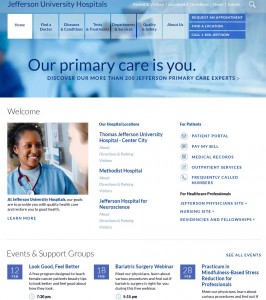What Are the Top Web Design Trends Today? Not Just Responsive Design
Ask The Expert with Ben Dillon
 With the growing number of ways that consumers access the Internet, responsive design is fast becoming the industry standard for hospital websites. Responsive design enables websites to adapt to the device being used, presenting an optimal experience on smartphones, tablets, and desktops. Research by Geonetric, an online solutions company, indicates that 26 percent of healthcare organizations currently have a responsive website, and of those that do not, 42 percent list it as a development priority for 2014.
With the growing number of ways that consumers access the Internet, responsive design is fast becoming the industry standard for hospital websites. Responsive design enables websites to adapt to the device being used, presenting an optimal experience on smartphones, tablets, and desktops. Research by Geonetric, an online solutions company, indicates that 26 percent of healthcare organizations currently have a responsive website, and of those that do not, 42 percent list it as a development priority for 2014.
“From 2012 to 2013 our mobile traffic more than doubled,” says Christy Bock, marketing specialist at Mercy Medical Center in Cedar Rapids, IA. “Traffic was a huge motivator for our move to a responsive site last year. Since launching the site, mobile traffic to our site has grown to be almost 40 percent of visits.”
Asante, a three-hospital system based in Medford, OR, has been experiencing similar growth in mobile traffic.
“Our mobile traffic has more than doubled each year since 2011,” says Philip Stanley, webmaster at Asante. “And 2014 appears to be on pace to exceed that level of growth. In many respects, mobile devices have become the default device rather than an afterthought.”
Philadelphia-based Thomas Jefferson University Hospitals moved from separate stand-alone mobile and desktop websites to a responsive site in November 2013 (Image No. 1). The organization saw some immediate benefits – including improved search engine optimization and a 508 percent increase in appointment request submissions from mobile devices.
This content is only available to members.
Please log in.
Not a member yet?
Start a free 7-day trial membership to get instant access.
Log in below to access this content:


